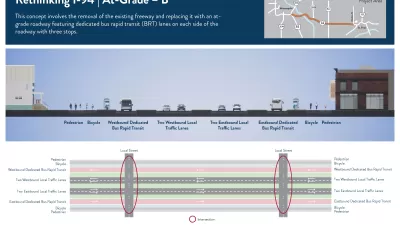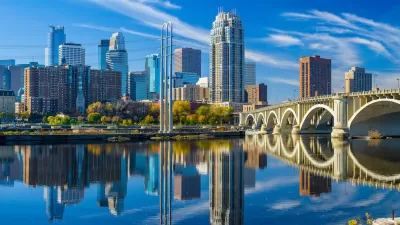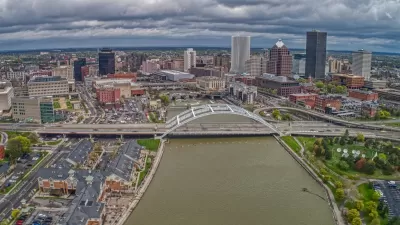Two ramps that have minimal impact on traffic could make way for apartments, commercial spaces, or much-needed parks.

Bill Lindeke argues that "a pair of one-lane viaducts looming in the middle of a lovely neighborhood, blotting out the sun atop massive concrete pillars surrounded by surface parking" have no place in their otherwise "thriving, cosmopolitan part of downtown" Minneapolis. According to Lindeke, the ramps likely "do more harm than good," saving about 15,000 drivers per day "maybe two minutes of travel time, and that’s if you are being very generous with route mapping." Meanwhile, the "marginally useful" ramps are surrounded by "some of the hottest real estate in the country."
"Back in the 1950s, building urban freeways through the downtown core seemed like a good idea with few drawbacks. But now, when downtowns are adding tens of thousands of new residents, it might be time to shift urban planning priorities." With freeway removal projects "becoming a hot trend" around the country, Lindeke argues the North Loop is an ideal candidate. "Based on the property tax receipts of the adjacent block, the land underneath the viaducts is worth at least $5 million of property tax revenue annually" and could be developed into housing, offices, and parks. "This example is as clear-cut a case as you’ll find in Minnesota of addition by subtraction, taking out an unneeded section of freeway, improving the downtown economy, and greening one of the city’s thriving neighborhoods."

Alabama: Trump Terminates Settlements for Black Communities Harmed By Raw Sewage
Trump deemed the landmark civil rights agreement “illegal DEI and environmental justice policy.”

Planetizen Federal Action Tracker
A weekly monitor of how Trump’s orders and actions are impacting planners and planning in America.

The 120 Year Old Tiny Home Villages That Sheltered San Francisco’s Earthquake Refugees
More than a century ago, San Francisco mobilized to house thousands of residents displaced by the 1906 earthquake. Could their strategy offer a model for the present?

San Francisco Opens Park on Former Great Highway
The Sunset Dunes park’s grand opening attracted both fans and detractors.

Oregon Legislature to Consider Transit Funding Laws
One proposal would increase the state’s payroll tax by .08% to fund transit agencies and expand service.

Housing Vouchers as a Key Piece of Houston’s Housing Strategy
The Houston Housing Authority supports 19,000 households through the housing voucher program.
Urban Design for Planners 1: Software Tools
This six-course series explores essential urban design concepts using open source software and equips planners with the tools they need to participate fully in the urban design process.
Planning for Universal Design
Learn the tools for implementing Universal Design in planning regulations.
Clanton & Associates, Inc.
Jessamine County Fiscal Court
Institute for Housing and Urban Development Studies (IHS)
City of Grandview
Harvard GSD Executive Education
Toledo-Lucas County Plan Commissions
Salt Lake City
NYU Wagner Graduate School of Public Service





























